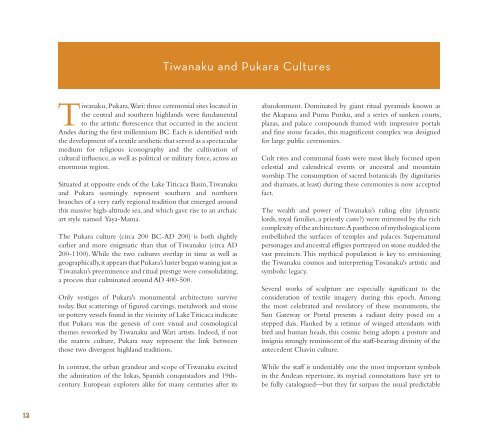You also want an ePaper? Increase the reach of your titles
YUMPU automatically turns print PDFs into web optimized ePapers that Google loves.
Tiwanaku and Pukara Cultures<br />
Tiwanaku, Pukara, Wari: three ceremonial sites located in<br />
<strong>the</strong> central and sou<strong>the</strong>rn highlands were fundamental<br />
to <strong>the</strong> artistic florescence that occurred in <strong>the</strong> ancient<br />
<strong>Andes</strong> during <strong>the</strong> first millennium BC. Each is identified with<br />
<strong>the</strong> development of a textile aes<strong>the</strong>tic that served as a spectacular<br />
medium for religious iconography and <strong>the</strong> cultivation of<br />
cultural influence, as well as political or military force, across an<br />
enormous region.<br />
Situated at opposite ends of <strong>the</strong> Lake Titicaca Basin, Tiwanaku<br />
and Pukara seemingly represent sou<strong>the</strong>rn and nor<strong>the</strong>rn<br />
branches of a very early regional tradition that emerged around<br />
this massive high-altitude sea, and which gave rise to an archaic<br />
art style named Yaya-Mama.<br />
The Pukara culture (circa 200 BC-AD 200) is both slightly<br />
earlier and more enigmatic than that of Tiwanaku (circa AD<br />
200-1100). While <strong>the</strong> two cultures overlap in time as well as<br />
geographically, it appears that Pukara’s luster began waning just as<br />
Tiwanaku’s preeminence and ritual prestige were consolidating,<br />
a process that culminated around AD 400-500.<br />
Only vestiges of Pukara's monumental architecture survive<br />
today. But scatterings of figured carvings, metalwork and stone<br />
or pottery vessels found in <strong>the</strong> vicinity of Lake Titicaca indicate<br />
that Pukara was <strong>the</strong> genesis of core visual and cosmological<br />
<strong>the</strong>mes reworked by Tiwanaku and Wari artists. Indeed, if not<br />
<strong>the</strong> matrix culture, Pukara may represent <strong>the</strong> link between<br />
those two divergent highland traditions.<br />
In contrast, <strong>the</strong> urban grandeur and scope of Tiwanaku excited<br />
<strong>the</strong> admiration of <strong>the</strong> Inkas, Spanish conquistadors and 19thcentury<br />
European explorers alike for many centuries after its<br />
abandonment. Dominated by giant ritual pyramids known as<br />
<strong>the</strong> Akapana and Puma Punku, and a series of sunken courts,<br />
plazas, and palace compounds framed with impressive portals<br />
and fine stone facades, this magnificent complex was designed<br />
for large public ceremonies.<br />
Cult rites and communal feasts were most likely focused upon<br />
celestial and calendrical events or ancestral and mountain<br />
worship. The consumption of sacred botanicals (by dignitaries<br />
and shamans, at least) during <strong>the</strong>se ceremonies is now accepted<br />
fact.<br />
The wealth and power of Tiwanaku’s ruling elite (dynastic<br />
lords, royal families, a priestly caste?) were mirrored by <strong>the</strong> rich<br />
complexity of <strong>the</strong> architecture. A pan<strong>the</strong>on of mythological icons<br />
embellished <strong>the</strong> surfaces of temples and palaces. Supernatural<br />
personages and ancestral effigies portrayed on stone studded <strong>the</strong><br />
vast precincts. This mythical population is key to envisioning<br />
<strong>the</strong> Tiwanaku cosmos and interpreting Tiwanaku's artistic and<br />
symbolic legacy.<br />
Several works of sculpture are especially significant to <strong>the</strong><br />
consideration of textile imagery during this epoch. Among<br />
<strong>the</strong> most celebrated and revelatory of <strong>the</strong>se monuments, <strong>the</strong><br />
Sun Gateway or Portal presents a radiant deity posed on a<br />
stepped dais. Flanked by a retinue of winged attendants with<br />
bird and human heads, this cosmic being adopts a posture and<br />
insignia strongly reminiscent of <strong>the</strong> staff-bearing divinity of <strong>the</strong><br />
antecedent Chavín culture.<br />
While <strong>the</strong> staff is undeniably one <strong>the</strong> most important symbols<br />
in <strong>the</strong> Andean repertoire, its myriad connotations have yet to<br />
be fully catalogued—but <strong>the</strong>y far surpass <strong>the</strong> usual predictable<br />
12







